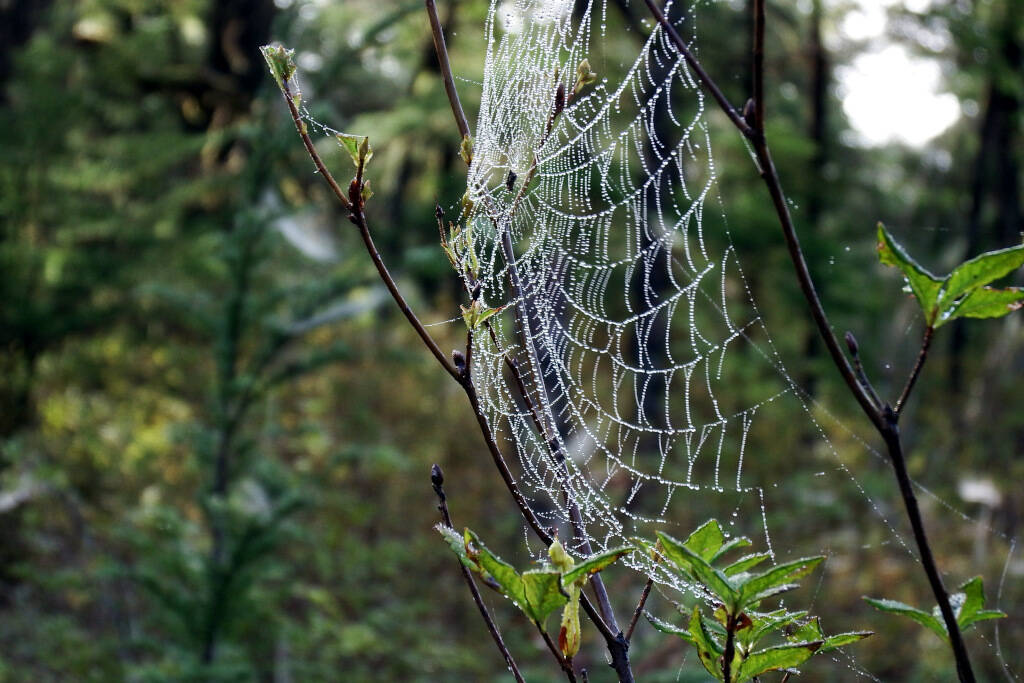We see silken spider webs in all kinds of places — in a corner of the garage that hasn’t seen a broom in months, in a window that was unoccupied yesterday, among some forked twigs as densely packed tangles, and that’s just the beginning. My favorites are the elegant orb-webs, stretched across an opening in the vegetation on radial silk lines that support a sturdy silk frame and a spiral of finer silk, making a mesh.
Spider silk is amazing stuff, incredibly light and amazingly strong. The silk is mostly protein, produced by glands in a viscous, semi-fluid form; the proteins get organized into fibers by chemical reactions as they pass from the gland through a duct to toward the outside. The viscous material hardens into a solid when it is extruded from the spider’s body, forming a strand. Each strand is a cable composed of many nano fibers (about 20 millionth of a millimeter in diameter) that, together, somehow make the strand strong. The tensile strength of spider silk is about as great as that of a steel fiber of equivalent size and weight, but the silk is more extensible before breaking and more flexible, whereas steel is stiff. (Tensile strength refers to the amount of lengthwise stress withstood without breaking).
The silk glands are located in what is called the opisthosoma, which is the rear part of the body behind the head and thorax. Technically, it is not the abdomen, because (along with the gut and reproductive organs) it houses the heart and respiratory organs (found in the thorax of many other animals).
Silk glands produce several different kinds of silk, which are used in different ways. The silk is extruded from spinnerets that are usually underneath the opisthosoma (sometimes at the rear end); most spiders have six of them but some species have two or four or eight. Spinnerets can be moved independently or in concert. Each spinneret has many microscopic spigots, connected to the various silk glands, and each spigot makes one ultra-fine line of silk from the nano fibers, which are combined into the strand of silk. The silk may be extruded by pressure from inside the body or pulled out by the spider’s legs. The kind of silk that emerges depends on which glands are activated.
A web has three functions: 1) positioning in potential path of prey, and orb-web weavers can orient the web with respect to light and wind; 2) stopping prey, thus absorbing the prey’s kinetic energy; and 3) retention of prey by adhesion and entrapment, until the spider arrives from wherever it was lurking nearby, perhaps at the edge of the web or in the center. The radial lines that support the web are relatively sturdy and do most of the job of stopping the prey. The finer lines of the spiral are typically sticky with glue; their function is prey capture and retention. They are designed to break before the glue fails to hold, as the prey struggles, so the loose ends of the broken strands may help restrain the prey.
Prey capture is a chancy business, dependent on prey density, weather, and whatnot. So orb weavers tend to move the sites for the webs fairly frequently. It is relatively cheap for them to do, compared to some spiders that weave very dense webs. In general, orb weavers can eat and digest part of the old web, thus recycling the protein, before they move on.
There are over three thousand species of orb-web spiders in the world. I don’t know how many occur in Southeast, but one of them is sometimes seen along our trails. It’s the shamrock orb-weaver (Araneus trifolium), which ranges all over North America. The opisthosoma is usually beige or brown, but sometimes it’s yellow, orange, or red; the legs have distinctive dark and light bands. Females are much fatter-looking than males, because they make several hundred eggs.
When she is ready to mate, she sends out airborne pheromones, to which the males respond. As the males enter a female’s web, they have to be careful, making distinctive, non-prey-like vibrations, so the hungry female doesn’t attack them. Mating occurs in autumn, and egg masses overwinter in cocoons that are glued to vegetation; cocoons are wrapped in silk, but a silk different from web silk.
This species builds rather large webs, up to two feet in diameter, usually in open sites between shrubs or herbaceous vegetation. In well-lit habitats, background patterns behind a web may make it hard for prey to see and avoid it, but in dimmer habitats, background patterns probably have little effect on prey detection of the webs. Males may build webs too, but they need to move around to find females, so their webs are likely to be smaller and fewer.
• Mary F. Willson is a retired professor of ecology. “On the Trails” appears every Wednesday in the Juneau Empire.

